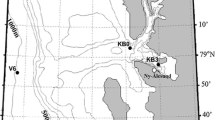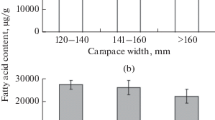Abstract
The lipid composition of tropical marine reef fishes is poorly known, despite their use as food by local human populations and recent interest in health-related benefits of fish lipids. We examined the composition of lipids from epaxial muscle, liver, and two storage sites [mesenteries surrounding the gut (intraperitoneal fat, IPFs) and retroperitoneal fat bodies (FBs) posterior to the peritoneal cavity] in three species of surgeonfishes from Ishigaki Island, Japan: Naso lituratus (Bloch and Schneider, 1801), Acanthurus lineatus (Linnaeus, 1758), and A. bariene (Lesson, 1830). Triacylglycerols dominated all samples of neutral lipid and constituted ≥ 99% of FBs and IPFs. Polar lipids generally contained large fractions of phosphatidylethanolamine and phosphatidylcholine. Quantified fatty acids ranged in length from C14 to C24. C16 fatty acids prevailed (>35% of neutral fatty acids, >23% of polar fatty acids), although C18 (>16 and >14%, respectively) and C20 acids (>8 and >19%, respectively) were also common. Saturated fatty acids, dominated by palmitic acid (16:0), comprised 38.7 to 50.7% of acids from neutral lipids and 30.8 to 41.1% from polar lipids. The most common monounsaturated acids were 18:1n9 and 20:1n9. Polyunsaturated acids were prevalent in polar lipids (especially 20:4n6, 20:5n3, 22:2n3, 22:5n3, 22:5n6 and 22:6n3). Common polyunsaturated acids of neutral lipids were 18:2n6, 18:4n3, several n-3 and n-6 C20 acids, 22:2n3 and 22:5n3. IPF and FB were almost identical across species, and lipids of fat bodies (IPFs, FBs) were more similar to those of muscle than those of liver for all three species. The FBs appear to constitute an accessory storage site, which overcomes constraints on lipid storage imposed by a small, inflexible abdominal cavity that contains both viscera and consistently voluminous gut contents. Fatty acid signatures indicate that largely overlooked epiphytic or epilithic diatoms contribute significantly to lipid acquisition. The combination of large quantities of both saturated and n-3 and other polyunsaturated fatty acids in surgeonfishes, in contrast to low saturates and high polyunsaturated acids in lipids of commercially important cool-water fishes, suggests that a study of dietary effects of fish lipids on human inhabitants of the tropics may be instructive insofar as human health and nutrition are concerned.
Similar content being viewed by others
Author information
Authors and Affiliations
Additional information
Received: 16 March 1998 / Accepted: 6 August 1998
Rights and permissions
About this article
Cite this article
Montgomery, W., Umino, T., Nakagawa, H. et al. Lipid storage and composition in tropical surgeonfishes (Teleostei: Acanthuridae). Marine Biology 133, 137–144 (1999). https://doi.org/10.1007/s002270050452
Issue Date:
DOI: https://doi.org/10.1007/s002270050452




